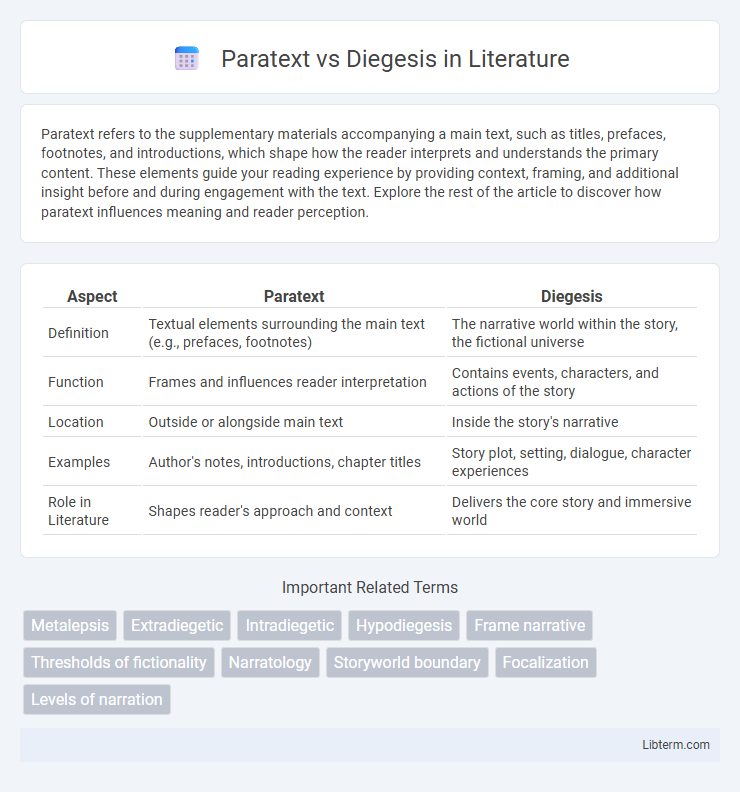Paratext refers to the supplementary materials accompanying a main text, such as titles, prefaces, footnotes, and introductions, which shape how the reader interprets and understands the primary content. These elements guide your reading experience by providing context, framing, and additional insight before and during engagement with the text. Explore the rest of the article to discover how paratext influences meaning and reader perception.
Table of Comparison
| Aspect | Paratext | Diegesis |
|---|---|---|
| Definition | Textual elements surrounding the main text (e.g., prefaces, footnotes) | The narrative world within the story, the fictional universe |
| Function | Frames and influences reader interpretation | Contains events, characters, and actions of the story |
| Location | Outside or alongside main text | Inside the story's narrative |
| Examples | Author's notes, introductions, chapter titles | Story plot, setting, dialogue, character experiences |
| Role in Literature | Shapes reader's approach and context | Delivers the core story and immersive world |
Understanding Paratext: Definition and Scope
Paratext encompasses all the supplementary materials surrounding a primary text, such as titles, prefaces, illustrations, and promotional content, which guide readers' interpretation and engagement. This concept, extensively analyzed by Gerard Genette, broadens the scope of literary analysis by including these threshold elements that frame the core narrative. Understanding paratext is crucial for interpreting how texts are presented and how meaning is negotiated between author, text, and audience.
Exploring Diegesis: Meaning and Application
Diegesis refers to the narrative world in which the story's events, characters, and objects exist, encompassing both the known and implied elements within a fictional universe. In literary theory and film studies, diegetic elements include any aspect that originates from within the story's universe, such as diegetic sounds like dialogue and footsteps, or narrative details that shape the characters' experiences. Understanding diegesis aids in distinguishing between what characters perceive and what the audience observes externally, enhancing the interpretation of storytelling techniques and narrative immersion.
Key Differences Between Paratext and Diegesis
Paratext encompasses the external elements surrounding a narrative, such as titles, prefaces, and illustrations, which guide reader interpretation but exist outside the main story. Diegesis refers to the internal world of the narrative itself, including the characters, events, and settings directly experienced within the story. The key difference lies in paratext serving as contextual framing or commentary, while diegesis constitutes the actual narrative content unfolding within the fictional universe.
The Role of Paratext in Narrative Construction
Paratext, including titles, prefaces, and illustrations, shapes readers' expectations and frames the narrative before the diegesis unfolds, serving as a gateway that influences interpretation and engagement. These peripheral elements guide the context and meaning, enriching the narrative construction by providing clues and subtext that extend beyond the diegetic content. The strategic deployment of paratextual components enhances narrative immersion and shapes the cognitive processing of the story world.
Diegesis and World-Building in Storytelling
Diegesis in storytelling refers to the narrative world that characters inhabit, encompassing all events, settings, and experiences within the fictional universe. It plays a crucial role in world-building by constructing a coherent and immersive environment that supports plot development and character interactions. A well-developed diegetic world enhances narrative depth, making the story's internal logic and cultural elements feel authentic to the audience.
Paratextual Elements: Examples and Significance
Paratextual elements include titles, prefaces, footnotes, and cover designs that frame and influence the reader's interpretation of a text, acting as a gateway to the main narrative. Examples such as J.R.R. Tolkien's foreword in "The Lord of the Rings" or the elaborate book covers of the "Harry Potter" series demonstrate how paratexts shape expectations and provide contextual clues beyond the core story. These elements hold significant value in literary studies and publishing as they guide the reception and understanding of the diegetic content, establishing a boundary between the story world and its external presentation.
Diegetic Elements: Internal Story Markers
Diegetic elements serve as internal story markers essential for grounding the narrative within its fictional world, including character dialogue, setting descriptions, and in-story sounds that characters perceive. These elements maintain narrative consistency and immersion by restricting the story's information to what exists inside the diegesis, thus excluding external commentary or authorial intervention found in paratext. Such internal markers help audiences differentiate between the story's reality and external narrative tools, reinforcing the boundary between diegetic content and paratextual elements that guide interpretation beyond the story world.
Paratext vs Diegesis in Literature and Film
Paratext in literature and film refers to the supplementary materials surrounding the main narrative, such as forewords, posters, trailers, and subtitles, which shape audience interpretation and context. Diegesis represents the internal world of the story, encompassing characters, settings, and events within the narrative itself. The distinction between paratext and diegesis is crucial for understanding how external elements influence reader or viewer engagement with the primary narrative across different media.
How Paratext Shapes Audience Interpretation
Paratext elements, such as book covers, titles, and author notes, shape audience interpretation by providing contextual clues before engaging with the main narrative, guiding expectations and framing the reading experience. These external texts influence how readers perceive the story's themes, tone, and genre, effectively shaping meaning beyond the diegetic content itself. Marketing materials and introductory elements function as paratexts that mediate the relationship between the audience and the core narrative world.
Blurring the Lines: Paratext and Diegesis Interactions
Paratext and diegesis interact by blurring boundaries between the narrative world and its surrounding texts, enhancing audience engagement and interpretative depth. Paratextual elements such as book covers, author's notes, and prologues extend the diegetic space by providing contextual cues that influence how the story is perceived. This interplay challenges traditional separations, as paratexts can become embedded within the narrative, creating a dynamic relationship that enriches the storytelling experience.
Paratext Infographic

 libterm.com
libterm.com